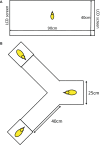Valproate Exposure in ovo Attenuates the Acquisition of Social Preferences of Young Post-hatch Domestic Chicks
- PMID: 31379596
- PMCID: PMC6646517
- DOI: 10.3389/fphys.2019.00881
Valproate Exposure in ovo Attenuates the Acquisition of Social Preferences of Young Post-hatch Domestic Chicks
Abstract
Embryonic exposure to valproic acid (VPA) is known to produce sociability deficits, resembling human autistic phenotypes, in several vertebrate species. Animals living in groups prefer the proximity of peers and have the ability to perceive and to respond to social signals for modifying behavior. Chicks of Galliform birds, known to display early preference behaviors, have been used extensively for adaptive learning studies. Young precocial birds seem to be useful models also for studying the effect of embryonic VPA treatment. Here, domestic chicken eggs were injected with sodium valproate (200 μl of 35 μmol/L solution) or with vehicle (distilled water) on the 14th day of incubation. After hatching, the chicks were tested for one-trial passive avoidance learning at day 1, vocalization due to isolation as a measure of stress level (day 2), approach preference to large versus small groups of age-matched conspecifics (day 5), and to those with normal versus blurred head features (day 7). In addition, we tested the preference of birds to conspecifics reared in group versus those reared in isolation (day 9), as well as the preference of chicks to familiar versus non-familiar conspecifics (day 21). Our findings confirm previous reports concerning an adverse effect of VPA on embryonic development, including a tendency for aborted or delayed hatching and, occasionally, for locomotor disorders in a small percentage of birds (eliminated from later studies). Otherwise, VPA treatment did not impair motor activity or distress level. Memory formation for the aversive stimulus and discrimination of colors were not impaired by VPA treatment either. Innate social predispositions manifested in approach preferences for the larger target group or for the birds with natural facial features remained unaffected by VPA exposure. The most prominent finding was attenuation of social exploration in VPA-exposed birds (expressed as the frequency of positional switches between two stimulus chicks after the first choice), followed by a deficit in the recognition of familiar conspecifics, unfolding at the end of the third week. Social exploration and recognition of familiar individuals are the key elements impaired at this stage. The results underline the importance of early social exploration in ASD.
Keywords: autism spectrum disorder; avian; developmental disorder; embryonic development; social brain network; social cohesion.
Figures







Similar articles
-
Spontaneous Visual Preference for Face-Like Stimuli Is Impaired in Newly-Hatched Domestic Chicks Exposed to Valproic Acid During Embryogenesis.Front Behav Neurosci. 2021 Nov 11;15:733140. doi: 10.3389/fnbeh.2021.733140. eCollection 2021. Front Behav Neurosci. 2021. PMID: 34858146 Free PMC article.
-
Embryonic Exposure to Valproic Acid Affects Social Predispositions for Dynamic Cues of Animate Motion in Newly-Hatched Chicks.Front Physiol. 2019 Apr 30;10:501. doi: 10.3389/fphys.2019.00501. eCollection 2019. Front Physiol. 2019. PMID: 31114510 Free PMC article.
-
Impaired social behavior in chicks exposed to sodium valproate during the last week of embryogenesis.Psychopharmacology (Berl). 2013 Jun;227(3):393-402. doi: 10.1007/s00213-013-2979-y. Epub 2013 Jan 31. Psychopharmacology (Berl). 2013. PMID: 23371491
-
Prenatal valproate in rodents as a tool to understand the neural underpinnings of social dysfunctions in autism spectrum disorder.Neuropharmacology. 2019 Nov 15;159:107477. doi: 10.1016/j.neuropharm.2018.12.024. Epub 2019 Jan 9. Neuropharmacology. 2019. PMID: 30639388 Review.
-
Filial responses as predisposed and learned preferences: Early attachment in chicks and babies.Behav Brain Res. 2017 May 15;325(Pt B):90-104. doi: 10.1016/j.bbr.2016.09.018. Epub 2016 Sep 8. Behav Brain Res. 2017. PMID: 27616345 Review.
Cited by
-
Early cellular and synaptic changes in dopaminoceptive forebrain regions of juvenile mice following gestational exposure to valproate.Front Neuroanat. 2023 Aug 3;17:1235047. doi: 10.3389/fnana.2023.1235047. eCollection 2023. Front Neuroanat. 2023. PMID: 37603782 Free PMC article.
-
Three Decades of Valproate: A Current Model for Studying Autism Spectrum Disorder.Curr Neuropharmacol. 2024;22(2):260-289. doi: 10.2174/1570159X22666231003121513. Curr Neuropharmacol. 2024. PMID: 37873949 Free PMC article. Review.
-
Spontaneous Visual Preference for Face-Like Stimuli Is Impaired in Newly-Hatched Domestic Chicks Exposed to Valproic Acid During Embryogenesis.Front Behav Neurosci. 2021 Nov 11;15:733140. doi: 10.3389/fnbeh.2021.733140. eCollection 2021. Front Behav Neurosci. 2021. PMID: 34858146 Free PMC article.
-
The Balance in the Head: How Developmental Factors Explain Relationships Between Brain Asymmetries and Mental Diseases.Brain Sci. 2025 Feb 9;15(2):169. doi: 10.3390/brainsci15020169. Brain Sci. 2025. PMID: 40002502 Free PMC article. Review.
-
Gestational VPA exposure reduces the density of juxtapositions between TH+ axons and calretinin or calbindin expressing cells in the ventrobasal forebrain of neonatal mice.Front Neuroanat. 2024 Jul 4;18:1426042. doi: 10.3389/fnana.2024.1426042. eCollection 2024. Front Neuroanat. 2024. PMID: 39026519 Free PMC article.
References
-
- Akhtar L., Khan M. Y., Minhas L. A. (2015). The effect of prenatal administration of valproic acid on the survivability and day of hatching of chick embryo. J. Pak. Med. Assoc. 65, 175–178. PMID: - PubMed
-
- Bangerter A., Ness S., Aman M. G., Esbensen A. J., Goodwin M. S., Dawson G., et al. . (2017). Autism behavior inventory: a novel tool for assessing core and associated symptoms of autism spectrum disorder. J. Child Adolesc. Psychopharmacol. 27, 814–822. 10.1089/cap.2017.0018, PMID: - DOI - PMC - PubMed
LinkOut - more resources
Full Text Sources

